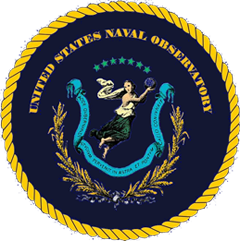USNO Circular 180
(Superceded by User's Guide to NOVAS 3.1)
User's Guide to NOVAS 3.0
George H. Kaplan, John A. Bangert, Jennifer L. Bartlett, Wendy K. Puatua, & Alice K. B. Monet
U.S. Naval Observatory
December 2009
Introduction:
Naval Observatory Vector Astrometry Software (NOVAS) is a source-code library in Fortran and C that provides common astrometric quantities and transformations. NOVAS calculations are accurate at the sub-milliarcsecond level. It can supply, in one or two subroutine or function calls, the instantaneous celestial position of any star or planet in a variety of coordinate systems. NOVAS also provides access to all of the "building blocks" that go into such computations — single-purpose subroutines or functions for common astrometric algorithms, such as those for precession, nutation, aberration, parallax, etc. The NOVAS package is an easy-to-use facility that can be incorporated into data reduction programs, telescope control systems, and simulations. The U.S. parts of The Astronomical Almanac are produced using NOVAS.
USNO Circular 180 describes NOVAS, version 3.0, which was released in December 2009 with extensive revisions to the code in response to recent International Astronomical Union (IAU) resolutions on astronomical reference systems, time scales, and Earth rotation models. (USNO Circular 179 explains these IAU resolutions in detail.) NOVAS now incorporates a coherent set of foundational standards for the treatment of astrometric data and the modeling of dynamics in the solar system. This version of NOVAS also improves the accuracy of its star and planet position calculations by including several small effects not previously implemented in the code. In addition, new convenience subroutines and functions have been added.
NOVAS algorithms are based on a rigorous vector and matrix formulation that does not use spherical trigonometry at any point. It treats objects inside and outside the solar system similarly. NOVAS fully supports all data compatible with the International
Celestial Reference System (ICRS), e.g.,
Hipparcos and Tycho Catalogs
, the
Tycho-2 Catalog
, the
International Celestial Reference Frame (ICRF)
, the
DJet
Propulsion Laboratory DE405 planetary ephemeris
, and Earth
orientation measurements from the
International Earth Rotation Service (IERS)
.
USNO Circular 180 consists of the User's Guides for both the Fortran and C editions of NOVAS 3.0. Additional information on the computation of nutation in NOVAS is available in USNO Circular 181.
In March 2011, NOVAS 3.1 was released with updated
User's Guides for the C and
Fortran editions. For technical
information on the current version of NOVAS, please consult either
User's Guide to NOVAS F3.1 or
User's Guide to NOVAS C3.1 as
appropriate for your application.
Rev. C is the last revision to USNO Circular 180. No further updates to this circular are planned.
Obtaining a Copy:
Download a Free Copy. USNO Circular 180 is available free of charge as a PDF document; the documents below incorporate the errata. Click on one of the links below to download the publication.
If you have a bound, printed version, you may download the errata list only by clicking on the link below.
- Errata PDF (174K) to accompany bound, printed version
Any text in color in the PDF files is "hot;" clicking on it will take you directly to the indicated resource.
Problems:
Please report any errors via our help desk.

